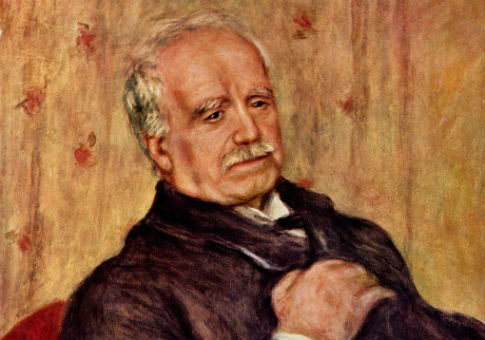On September 1, 1870, the Prussian troops of Field Marshal Helmuth von Moltke—accompanied on the battlefield by both Chancellor Bismark and the Kaiser—crushed the French army at Sedan and took Napoleon III prisoner, ending the French Second Empire and inspiring a middle-aged, politically conservative art dealer named Paul Durand-Ruel to pack up his gallery in Paris and escape to London.
It was there, in January of 1871, that Durand-Ruel met Monet, also in temporary exile as the Germans lay siege to Paris. No doubt impressed by the fact that this mild mannered Roman Catholic paid him 300 francs each for several of his most recent avant-garde paintings—significantly more than his work was fetching at the time—Monet introduced Durand-Ruel to Pissarro, for whom Durand-Ruel repeated his generous performance, offering 400 francs for two paintings from the unfashionable, little known artist.
And so, in a sense, Impressionism—though it did not yet have a name, or even the sense of a distinct movement—was born. Only in a sense, of course: Monet, Pissarro, and elsewhere Manet, Degas, and Sisley were already engaged in their separate explorations of subjectivity and perception, and in many cases were already in contact with one another. But, as they would all later attest, one person was indispensable: this polite, conventional man with the money, some business sense, and what, to the family he doted on, must have seemed an alarming degree of boldness.
Now making its final stop at the Philadelphia Museum of Art, after time in Paris and London, is an exhibition devoted to the story of Impressionism as told through Durand-Ruel’s role in the movement. Such a conceit might sound tedious or precious, designed, as are too many exhibits, to suit the narrow interests of the curators, rather than those of the museum-going public. But it is not tedious or precious or narrow. This is a magnificent show, in which a strong narrative element manages not to smother the art but to elevate it. On the East Coast, the most recent exhibit to achieve something similar was the Smithsonian American Art Museum’s 2012-2013 show on Civil War art.
James Salter once wrote of a book about Paris and eating by the journalist A.J. Liebling that it bore "the unmistakable signature of a real writer: an entire book thrown away on nearly every page." Discovering the Impressionists is like that—an entire exhibit thrown away in nearly every room. The galleries are arranged chronologically, so first we have a display devoted to Durand-Ruel’s early dealings with the Barbizon School, and then a series of spaces organized around Impressionist shows backed by the dealer, each with samples of the paintings that originally appeared in those shows.
Other spaces are devoted to significant purchases, as when, in January of 1872, Durand-Ruel suddenly bought 23 paintings by Manet for 35,000 francs. This was not impulse, but the beginning of a business plan aiming at cornering the Manet market, such as it was in 1872, and thus at inflating the price for Manets.
Like many of Durand-Ruel’s investments, this one was for the long-term, and far from risk-free. Manet was producing what were, to some, quite offensive send-ups of established genres. Consider his Battle of the U.S.S. Kearsage and the C.S.S. Alabama, in every superficial respect an example of history painting, depicting a significant event with appropriate drama—but in every important respect, a study not of battle or history, but of water.
And more than just water—a terrifying, vertiginous, highly subjective look at water in which men are drowning, in which you may as well be drowning. Edgy an approach as this was, it had nothing on another of Durand-Ruel’s investments, Degas’ Peasant Girls Bathing in the Sea at Dusk, the unfinished look of which foreshadows Post-Impressionism and the art of the subsequent generation.
Like Manet in his depiction of the sea battle, Degas seems to be making an effort to disorient the viewer. There is also a visual showmanship at work, easier to see in the gallery than in reproduction: puncturing the flat browns of the girls’ bodies and the dirty waves is a tunnel of deep space (what filmmakers would later call deep focus) in the upper left, in which one sees a placid, pleasantly lit sunset that could have been sketched by Turner 50 years earlier.
Disorientation, subjectivity, the presentation of a painting as the communication of a subjective experience or perception, rather than as a convincing illusion—this was not everyone’s cup of tea in 1876. But to Degas, to Monet, and to the rest, these things mattered: painting was not photography, but better and more important than photography, because instead of just communicating what happened to be visible, a painter communicated what was necessary, or essential, or true. There is a way in which the half-skinned lemon in Manet’s still life The Salmon looks more sour or tart than any lemon in a photograph—or maybe than most actual lemons.
There are around a hundred paintings in this exhibit—many, many Monets, including the reunion of a half dozen of his studies of the poplars near Giverny; over a dozen significant Renoirs; a half dozen Sisleys; more. Like one of Liebling’s meals, it is possible to feel overwhelmed, and the narrative thread of Durand-Ruel’s career provides a useful handhold with which to pull oneself through to the end.
It is ironic that such unusual men as these painters found their most important early backer in a man of such conventional personal habits—a devout Catholic, and a conservative family man. Or, perhaps, it is not ironic at all that the permanent avant-garde, in order to establish itself, needed a businessman like Paul Durand-Ruel.
